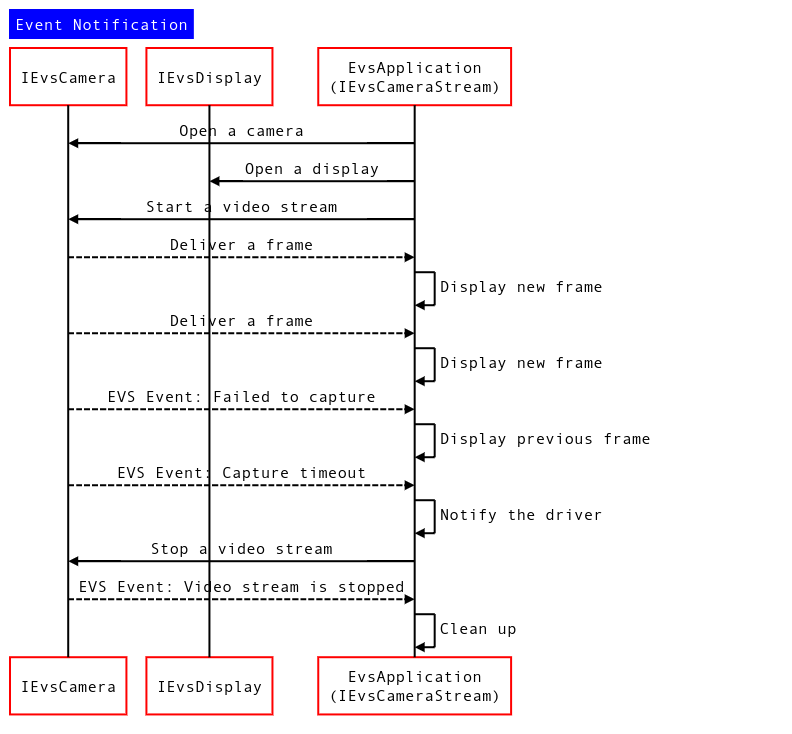在上一版本的外景系统 (EVS) 中,IEvsCameraStream 接口定义了一个回调方法,仅用于传递捕获的视频帧。虽然此回调方法简化了 EVS 服务客户端的实现,但它也使客户端难以识别任何流式传输突发事件,因而难以妥善处理相应突发事件。为了增强 EVS 开发体验,AOSP 现在包含一个用于传递流式传输事件的额外回调。
package android.hardware.automotive.evs@1.1; import @1.0::IEvsCameraStream; /** * Implemented on client side to receive asynchronous video frame deliveries. */ interface IEvsCameraStream extends @1.0::IEvsCameraStream { /** * Receives calls from the HAL each time a video frame is ready for inspection. * Buffer handles received by this method must be returned via calls to * IEvsCamera::doneWithFrame_1_1(). When the video stream is stopped via a call * to IEvsCamera::stopVideoStream(), this callback may continue to happen for * some time as the pipeline drains. Each frame must still be returned. * When the last frame in the stream has been delivered, STREAM_STOPPED * event must be delivered. No further frame deliveries may happen * thereafter. * * @param buffer a buffer descriptor of a delivered image frame. */ oneway deliverFrame_1_1(BufferDesc buffer); /** * Receives calls from the HAL each time an event happens. * * @param event EVS event with possible event information. */ oneway notify(EvsEvent event); };
此方法传递的 EvsEventDesc 由三个字段组成:
- 事件的类型。
- 用于标识事件来源的字符串。
- 4 个 32 位字数据,用于包含可能需要提供的事件信息。
/** * Structure that describes informative events occurred during EVS is streaming */ struct EvsEvent { /** * Type of an informative event */ EvsEventType aType; /** * Device identifier */ string deviceId; /** * Possible additional information */ uint32_t[4] payload; };
此外,为了避免 EVS 与其他 Android 图形组件之间在图形缓冲区说明方面存在任何差异,BufferDesc 已重新定义为使用从 android.hardware.graphics.common@1.2 接口导入的 HardwareBuffer。HardwareBuffer 包含带有缓冲区句柄的 HardwareBufferDescription,后者在 HIDL 中与 Android NDK 的 AHardwareBuffer_Desc 相对应。
/** * HIDL counterpart of AHardwareBuffer_Desc. * * An AHardwareBuffer_Desc object can be converted to and from a * HardwareBufferDescription object by memcpy(). * * @sa +ndk libnativewindow#AHardwareBuffer_Desc. */ typedef uint32_t[10] HardwareBufferDescription; /** * HIDL counterpart of AHardwareBuffer. * * AHardwareBuffer_createFromHandle() can be used to convert a HardwareBuffer * object to an AHardwareBuffer object. * * Conversely, AHardwareBuffer_getNativeHandle() can be used to extract a native * handle from an AHardwareBuffer object. Paired with AHardwareBuffer_Desc, * AHardwareBuffer_getNativeHandle() can be used to convert between * HardwareBuffer and AHardwareBuffer. * * @sa +ndk libnativewindow#AHardwareBuffer". */ struct HardwareBuffer { HardwareBufferDescription description; handle nativeHandle; } /** * Structure representing an image buffer through our APIs * * In addition to the handle to the graphics memory, need to retain * the properties of the buffer for easy reference and reconstruction of * an ANativeWindowBuffer object on the remote side of API calls. * (Not least because OpenGL expect an ANativeWindowBuffer* for us as a * texture via eglCreateImageKHR(). */ struct BufferDesc { /** * HIDL counterpart of AHardwareBuffer_Desc. Please see * hardware/interfaces/graphics/common/1.2/types.hal for more details. */ HardwareBuffer buffer; /** * The size of a pixel in the units of bytes */ uint32_t pixelSize; /** * Opaque value from driver */ uint32_t bufferId; /** * Unique identifier of the physical camera device that produces this buffer. */ string deviceId; /** * Time that this buffer is being filled */ int64_t timestamp; /** * Frame metadata. This is opaque to EVS manager */ vec<uint8_t> metadata };
注意:HardwareBufferDescription 被定义为由 10 个 32 位字组成的数组。建议您将其转换为 AHardwareBuffer_Desc 类型并填充内容。
EvsEventDesc 是类型为 enum EvsEventType 的结构,列出了多个流式传输事件和一个 32 位字载荷,开发者可在其中添加可能需要提供的其他信息。例如,开发者可针对流式传输错误事件添加一个错误代码。
/** * Types of informative streaming events */ enum EvsEventType : uint32_t { /** * Video stream is started */ STREAM_STARTED = 0, /** * Video stream is stopped */ STREAM_STOPPED, /** * Video frame is dropped */ FRAME_DROPPED, /** * Timeout happens */ TIMEOUT, /** * Camera parameter is changed; payload contains a changed parameter ID and * its value */ PARAMETER_CHANGED, /** * Master role has become available */ MASTER_RELEASED, };
帧传递
有了新的 BufferDesc,IEvsCameraStream 还引入了新的回调方法,用于从服务实现接收帧和流式传输事件。
/** * Implemented on client side to receive asynchronous streaming event deliveries. */ interface IEvsCameraStream extends @1.0::IEvsCameraStream { /** * Receives calls from the HAL each time video frames are ready for inspection. * Buffer handles received by this method must be returned via calls to * IEvsCamera::doneWithFrame_1_1(). When the video stream is stopped via a call * to IEvsCamera::stopVideoStream(), this callback may continue to happen for * some time as the pipeline drains. Each frame must still be returned. * When the last frame in the stream has been delivered, STREAM_STOPPED * event must be delivered. No further frame deliveries may happen * thereafter. * * A camera device will deliver the same number of frames as number of * backing physical camera devices; it means, a physical camera device * sends always a single frame and a logical camera device sends multiple * frames as many as the number of backing physical camera devices. * * @param buffer Buffer descriptors of delivered image frames. */ oneway deliverFrame_1_1(vec<BufferDesc> buffer); /** * Receives calls from the HAL each time an event happens. * * @param event EVS event with possible event information. */ oneway notify(EvsEventDesc event); };
较新版本的帧回调方法旨在传递多个缓冲区描述符。因此,如果 EVS 相机实现管理着多个源,就可以通过单次调用转发多个帧。
此外,以前通过发送 null 帧来通知数据流结束的协议已弃用并被 STREAM_STOPPED 事件所取代。

图 1. 事件通知序列图
使用事件和帧通知机制
确定由客户端实现的 IEvsCameraStream 的版本
该服务可以通过尝试向下转换来确定由客户端实现的传入 IEvsCameraStream 接口的版本:
using IEvsCameraStream_1_0 = ::android::hardware::automotive::evs::V1_0::IEvsCameraStream; using IEvsCameraStream_1_1 = ::android::hardware::automotive::evs::V1_1::IEvsCameraStream; Return<EvsResult> EvsV4lCamera::startVideoStream( const sp<IEvsCameraStream_1_0>& stream) { IEvsCameraStream_1_0 aStream = stream; // Try to downcast. This will succeed if the client implements // IEvsCameraStream v1.1. IEvsCameraStream_1_1 aStream_1_1 = IEvsCameraStream_1_1::castFrom(aStream).withDefault(nullptr); if (aStream_1_1 == nullptr) { ALOGI("Start a stream for v1.0 client."); } else { ALOGI("Start a stream for v1.1 client."); } // Start a video stream ... }
notify() 回调
EvsEvent 将通过 notify() 回调进行传递,然后客户端就可以根据判别器确定其类型,如下所示:
Return<void> StreamHandler::notify(const EvsEvent& event) { ALOGD("Received an event id: %u", event.aType); // Handle each received event. switch(event.aType) { case EvsEventType::ERROR: // Do something to handle an error ... break; [More cases] } return Void(); }
使用 BufferDesc
AHardwareBuffer_Desc 是 Android NDK 的数据类型,用于表示可绑定到 EGL/OpenGL 和 Vulkan 基元的原生硬件缓冲区。它包含以前的 EVS BufferDesc 中的大多数缓冲区元数据,并因此在新的 BufferDesc 定义中将其取而代之。但是,由于此数据类型被定义为 HIDL 接口中的一个数组,因此无法直接将成员变量编入索引。不过,您可以将该数组转换为 AHardwareBuffer_Desc 类型,如下所示:
BufferDesc bufDesc = {}; AHardwareBuffer_Desc* pDesc = reinterpret_cast<AHardwareBuffer_Desc *>(&bufDesc.buffer.description); pDesc->width = mVideo.getWidth(); pDesc->height = mVideo.getHeight(); pDesc->layers = 1; pDesc->format = mFormat; pDesc->usage = mUsage; pDesc->stride = mStride; bufDesc_1_1.buffer.nativeHandle = mBuffers[idx].handle; bufDesc_1_1.bufferId = idx;
